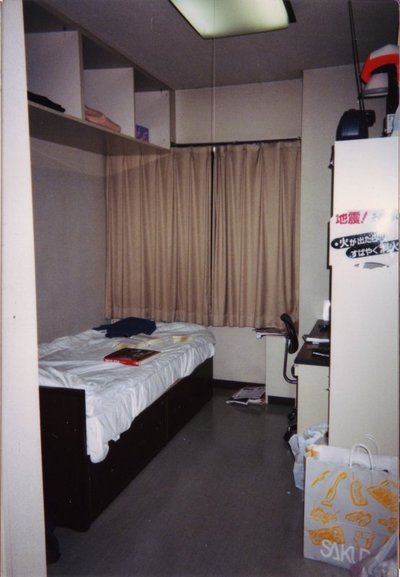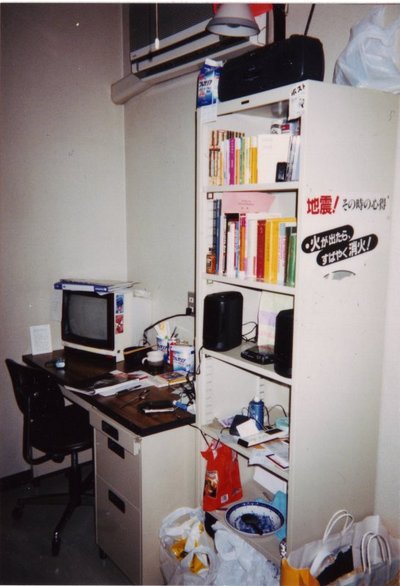Wednesday, January 16, 2008 5:32 PM
Room with a bed
As Shari enjoys seeing pictures of other people's places, and I happened to come across some old photographs, here the interior of my first ever residence in Japan, dating from 1996:

It was a room in a student dormitory located on the wild western edge of Setagaya-ku, about halfway between Seijô-Gakuen (Odakyu Line) and Sengawa (Keio Line) stations. The dormitory was exclusively for foreign students (留学生), mainly (but not entirely) on scholarships from the Education Ministry. As these places go, it was quite nice, with lots of facilities including a gym, common room, library and even some computers with very limited internet access. There were about 300 residents from all over the world, so it was very international.
The single rooms were mainly like mine in the photo above. Almost like a business hotel room, with quite a large and comfortable bed, a desk and some shelves for books. Each room had its own WC (not visible in the picture, but it would be immediately on the left). There were shared shower units on every block. The room was maybe 10 or 12 m². There was a balcony, but it was a bit pointless as the only way to get to it was to climb out through the window. I can't remember exactly how much the rent was; certainly over 30,000 yen, and probably a little under 35,000. Electricity was probably extra; I seem to recall being impressed by the fact I could pay the bill at 3am in the konbini over the road. I think there was also a laundry service for the bedclothes as part of the deal, and coin-operated washing machines for all other laundry.
This is a more detailed view of the study area. It looks quite grim but that's due to the picture quality.

The TV was second-hand (one of the many items passed on between student generations) and was my most useful tool for learning Japanese at the start (due to the way I'd studied, I could read fairly well but had zilch listening ability). Just visible in front of the TV is my PHS, thefirst mobile telephone I ever owned and a far cheaper option than shelling out a ridiculous deposit for an NTT phone line. Unfortunately I had no reception in that room and had to go out down the corridor regularly to see if I'd missed any calls.
The bowl on one of the lower shelves was a signing-up gift from Fuji Bank and for someone who'd arrived in Japan with very little, it proved to be surprisingly useful. (Alas, the Fuji Bank is no more, having been swallowed up into one of the merger-created megabanks, and the bowl has vanished into the mists of time). The sign on the side of the shelf unit has instructions on what to do in case of an earthquake. It wasn't standard in the rooms - I'd found it outside following a typhoon, during which it had evidently broken off from somewhere. (Being on the ground floor I never felt any earthquakes in that place).
All in all it wasn't a bad place to live. Unfortunately it had two major disadvantages. Firstly it was a long slog from the station: about 20 minutes by foot, or a 200 yen bus ride. (I could have obtained a bicycle, I suppose, but I think parking at Seijô Gakuen station was hard to come by and would have involved paying some silly figure like 5,000 yen a month for the privilege. The station in the other direction, Sengawa, actually had free parking, but that was because no express trains stopped there and it took something like 20 minutes longer to get to Shinjuku). Secondly, I was there to learn Japanese, and being shut away with 300 other foreigners on the edge of Tokyo proper (the ku / shi boundary was about two blocks away) wasn't doing my Japanese much good, so after about 6 months I moved somewhere much closer to the Yamanote line and with tatami.
